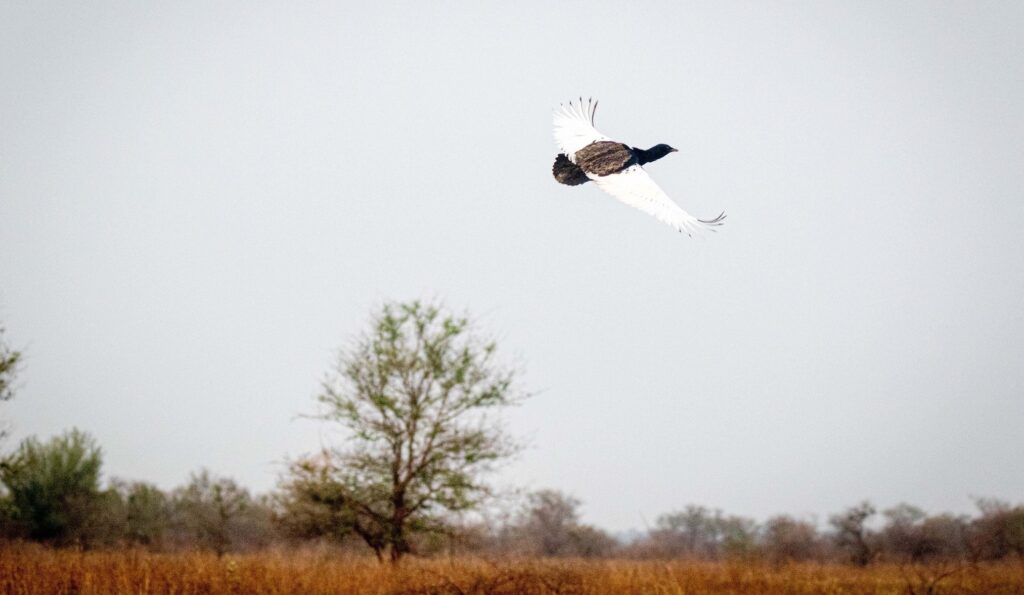The global population is estimated at fewer than 1,000 individuals.

The Bengal Florican (Houbaropsis bengalensis) is one of the world’s rarest bustard species. Classified as Critically Endangered by the International Union for Conservation of Nature (IUCN), the global population is estimated at fewer than 1,000 individuals. In Nepal, it is one of nine protected species under clause 10 of the National Parks and Wildlife Conservation Act 2029 (1973). Its inclusion in CITES Appendix I further underscores the urgent need for stringent conservation efforts.
BirdLife International, the official IUCN Red List authority for birds, has listed the Bengal Florican as Critically Endangered. Initially categorized as Threatened in 1988, it was listed as Endangered from 1994 to 2004 and finally upgraded to Critically Endangered in 2007.
Globally, the Bengal Florican is distributed in two isolated populations: one in Southeast Asia (Cambodia, subspecies Houbaropsis bengalensis blandini) and the other in South Asia (India and Nepal, subspecies Houbaropsis bengalensis bengalensis).
Historically, it inhabited the lowland grasslands of the Terai region. However, due to habitat loss from grassland conversion into agricultural land, human settlements, plantations, natural succession, and hunting, the current breeding distribution is restricted to a few protected grassland areas and farmlands during the non-breeding season.
The Bengal Florican is a grassland bird that thrives in dry grasslands. It favors relatively open short grass for establishing territories, often within expanses of tall grass and scattered shrubs. While short grasslands are preferred for foraging and displaying, the birds seek shelter in tall grass during the day’s heat. Females, in particular, spend much of their time in tall grass during the breeding season.
During the non-breeding season, the birds migrate to short grasslands and farmlands. Recent studies indicate that the birds leave their breeding grasslands when the vegetation height exceeds optimal levels. However, the ecology of the non-breeding season and the reasons for this migration still require further investigation.
The Bengal Florican exhibits sexual dimorphism, with males being black and white and females being brown. The breeding season extends from late March to early July. During this time, males become highly territorial and display cryptic coloration against burnt grass and flowering Imperata cylindrica. They are typically solitary and perform aerial displays to assert dominance, sometimes engaging in brief chases and fights with other males. These displays occur within fixed territories, with territorial males making long circular flights with shallow, rapid wingbeats, showcasing their conspicuous white wings.
The Bengal Florican faces numerous threats, primarily due to human dependence on grasslands for thatching roofs, fishing, and gathering fruits and vegetables. Feral cattle also contribute to habitat degradation. The most significant threat to the species is the loss and modification of its grassland habitat. Overgrazing and disturbance from human and cattle activities, particularly during the breeding season, pose serious threats.
At Koshi Tappu Wildlife Reserve (KTWR) and adjacent areas, large numbers of domestic cattle and people have been documented during the breeding season. While the impact of grazing on grassland ecology is not fully understood, some level of cattle grazing may benefit the Bengal Florican, necessitating further research. Uncontrolled human presence in KTWR also leads to untimely, accidental, and repeated fire events during the breeding season. Degrading grasslands by invasive species like Mikania micrantha is a significant problem at KTWR and Chitwan National Park (CNP). Additionally, the rise in predators such as the Asiatic golden jackal, Indian grey mongoose, and feral dogs has been identified as a potential threat at KTWR.
